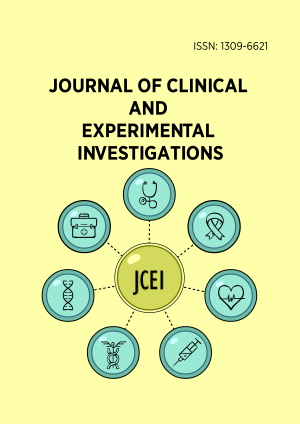Volume 3, Issue 1, March 2012
Research Article
Assessment of prolactin associated platelet activation in ischemic stroke
J Clin Exp Invest, Volume 3, Issue 1, March 2012, 1-6
https://doi.org/10.5799/ahinjs.01.2012.01.0101Research Article
Clinical comparison of cross-pin and EndoButton for fixation of hamstring grafts
J Clin Exp Invest, Volume 3, Issue 1, March 2012, 7-12
https://doi.org/10.5799/ahinjs.01.2012.01.0102Research Article
Relation between epicardial fat tissue and atrial fibrillation
J Clin Exp Invest, Volume 3, Issue 1, March 2012, 13-17
https://doi.org/10.5799/ahinjs.01.2012.01.0103Research Article
Characteristics of bean aspiration in children
J Clin Exp Invest, Volume 3, Issue 1, March 2012, 18-21
https://doi.org/10.5799/ahinjs.01.2012.01.0104Research Article
Relationship between total antioxidant capacity and the severity of coronary artery disease
J Clin Exp Invest, Volume 3, Issue 1, March 2012, 22-28
https://doi.org/10.5799/ahinjs.01.2012.01.0105Research Article
Association between neutrophil/lymphocyte ratio and coronary collateral circulation
J Clin Exp Invest, Volume 3, Issue 1, March 2012, 29-32
https://doi.org/10.5799/ahinjs.01.2012.01.0106Research Article
The comparison of effects of intrathecal two different levobupivacaine doses in appendectomy
J Clin Exp Invest, Volume 3, Issue 1, March 2012, 33-37
https://doi.org/10.5799/ahinjs.01.2012.01.0107Research Article
Clinical and laboratory characteristics and associated risk factors of infants hospitalized in newborn unit for indirect hyperbilirubinemia
J Clin Exp Invest, Volume 3, Issue 1, March 2012, 38-43
https://doi.org/10.5799/ahinjs.01.2012.01.0108Research Article
Urological laparoscopic surgery: Our experience of first 100 cases in Dicle University
J Clin Exp Invest, Volume 3, Issue 1, March 2012, 44-48
https://doi.org/10.5799/ahinjs.01.2012.01.0109Research Article
The relationship between gestation and iron deficiency anemia in women applied to obstetrics and gynecology outpatient clinic
J Clin Exp Invest, Volume 3, Issue 1, March 2012, 49-52
https://doi.org/10.5799/ahinjs.01.2012.01.0110Research Article
Comparison of the efficacy of dexmedetomidine and esmolol in the treatment of increased hemodynamic response during the recovery period
J Clin Exp Invest, Volume 3, Issue 1, March 2012, 53-60
https://doi.org/10.5799/ahinjs.01.2012.01.0111Research Article
Investigation of Toxoplasma gondii antibodies with ELISA among women of childbearing age in Şanlıurfa province: A three years evaluation
J Clin Exp Invest, Volume 3, Issue 1, March 2012, 61-65
https://doi.org/10.5799/ahinjs.01.2012.01.0112Research Article
Evaluation of the role of digital rectal examination and prostate specific antigen in diagnosis of prostate cancer
J Clin Exp Invest, Volume 3, Issue 1, March 2012, 66-70
https://doi.org/10.5799/ahinjs.01.2012.01.0113Research Article
Antibacterial susceptibility patterns of methicillin resistant staphylococcus spp. from a tertiary reference hospital
J Clin Exp Invest, Volume 3, Issue 1, March 2012, 71-74
https://doi.org/10.5799/ahinjs.01.2012.01.0114Research Article
The comparison of the effect of intrathecal levobupivacaine and bupivacaine for ano-rectal surgery
J Clin Exp Invest, Volume 3, Issue 1, March 2012, 75-80
https://doi.org/10.5799/ahinjs.01.2012.01.0115Research Article
The comparison of audiological tests and VAS scores after use of trimetazidine hydrocloride in patients with tinnitus
J Clin Exp Invest, Volume 3, Issue 1, March 2012, 81-86
https://doi.org/10.5799/ahinjs.01.2012.01.0116Research Article
Importance of nonspecific laboratory tests in Brucella diagnosis
J Clin Exp Invest, Volume 3, Issue 1, March 2012, 87-90
https://doi.org/10.5799/ahinjs.01.2012.01.0117Research Article
Henoch-Schönlein purpura in childhood: Review of 214 patients
J Clin Exp Invest, Volume 3, Issue 1, March 2012, 91-95
https://doi.org/10.5799/ahinjs.01.2012.01.0118Case Report
Ovarian malignant melanoma presenting with hypercalcemia and bone marrow infiltration: a case report and review of the literature
J Clin Exp Invest, Volume 3, Issue 1, March 2012, 96-98
https://doi.org/10.5799/ahinjs.01.2012.01.0119Case Report
Bilateral branchial cleft anomaly type two and type three seen together
J Clin Exp Invest, Volume 3, Issue 1, March 2012, 99-101
https://doi.org/10.5799/ahinjs.01.2012.01.0120Case Report
Acute arthritis as initial presentation of sarcoidosis: Significance of chest X-ray
J Clin Exp Invest, Volume 3, Issue 1, March 2012, 102-104
https://doi.org/10.5799/ahinjs.01.2012.01.0121Case Report
Treatment of cornual viable pregnancy with single dose methotrexate: Case report
J Clin Exp Invest, Volume 3, Issue 1, March 2012, 105-107
https://doi.org/10.5799/ahinjs.01.2012.01.0122Case Report
Essential tremor responsive to levetiracetam
J Clin Exp Invest, Volume 3, Issue 1, March 2012, 108-110
https://doi.org/10.5799/ahinjs.01.2012.01.0123Case Report
A rare case of intraosseous ganglion of the triquetrum
J Clin Exp Invest, Volume 3, Issue 1, March 2012, 111-112
https://doi.org/10.5799/ahinjs.01.2012.01.0124Case Report
Successful radiofrequency ablation of multiple accessory pathways in a patient with tachycardiomyopathy
J Clin Exp Invest, Volume 3, Issue 1, March 2012, 113-116
https://doi.org/10.5799/ahinjs.01.2012.01.0125Case Report
Brucellar epididymoorchitis: A case report
J Clin Exp Invest, Volume 3, Issue 1, March 2012, 117-120
https://doi.org/10.5799/ahinjs.01.2012.01.0126Case Report
A case with Stenotrophomonas maltophilia keratitis related to contact lens use
J Clin Exp Invest, Volume 3, Issue 1, March 2012, 121-122
https://doi.org/10.5799/ahinjs.01.2012.01.0127Case Report
A rare case of coagulation disorder presenting with unexpected bleeding non-responding to fresh frozen plasma replacement: Factor XIII deficiency
J Clin Exp Invest, Volume 3, Issue 1, March 2012, 123-126
https://doi.org/10.5799/ahinjs.01.2012.01.0128Case Report
A case report of renal Ewing sarcoma
J Clin Exp Invest, Volume 3, Issue 1, March 2012, 127-129
https://doi.org/10.5799/ahinjs.01.2012.01.0129Case Report
An uncommon cause of acute abdomen: Isolated small bowel obstruction due to gastrointestinal stromal tumor
J Clin Exp Invest, Volume 3, Issue 1, March 2012, 130-132
https://doi.org/10.5799/ahinjs.01.2012.01.0130Review
Cleidocranial dysplasia: Etiology, clinicoradiological presentation and management
J Clin Exp Invest, Volume 3, Issue 1, March 2012, 133-136
https://doi.org/10.5799/ahinjs.01.2012.01.0131Review
Current treatment methods in osteoarthritis
J Clin Exp Invest, Volume 3, Issue 1, March 2012, 137-140
https://doi.org/10.5799/ahinjs.01.2012.01.0132Review
An industrial risk: Beryllium
J Clin Exp Invest, Volume 3, Issue 1, March 2012, 141-148
https://doi.org/10.5799/ahinjs.01.2012.01.0133Review
Early and late endocrinologic complications of the hematopoetic stem cell transplantation performed for hematologic malignancies
J Clin Exp Invest, Volume 3, Issue 1, March 2012, 149-150
https://doi.org/10.5799/ahinjs.01.2012.01.0134
